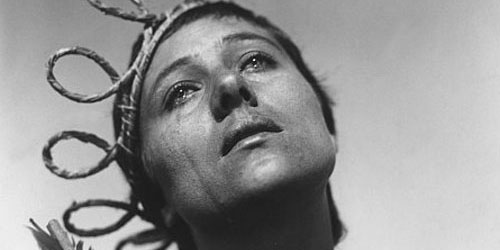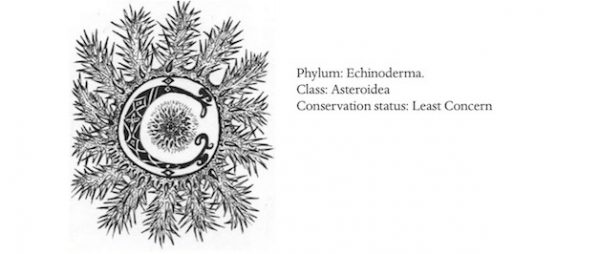ST. JOAN
The great actress Renée Jeanne Falconetti stands trial for heresy, a woeful story told with her eyes and their shadows, deep ponds of grey long-written about. Carl Theodor Dreyer’s La Passion de Jeanne d’Arc was filmed in 1928. Falconetti’s Joan wobbles between the fortitude of her beliefs and the struggle of her impertinence. Poor girl soldier. Down some wild time tunnel that unfurls to reconnect us, it’s 1431. She’s nineteen years old. The judges at her trial are glib and rotund, spoils of screaming meat robed and hooded, their spittle landing on her cheek in sharp whips.
FRAGMENTS
The iconography of the Catholic Church calls to me on every damned vacation I can remember taking. I can’t resist visiting ornately carved altars where tokens of grotesque and antiquated clues to faith, and to the unravelling of faith, are tucked away. Teeth, bone fragments, hair, splinters and textiles. Burned, flooded, bloodied, treasured. Put them together and an odiferous lair of mystical toxicity could sink a parallel world. Where does the pain go that pulls people apart, bloodying them, setting them on fire, yanking out teeth?
On a bookshelf in my living room, there is a ceramic Noah’s Ark container that fits in my palm. The bottom half is the boat, and its lid is decorated with sculpted giraffes and elephants, desperate for their storied escape, but smiling their animal smiles all the same. Inside, I’ve stowed my son’s baby teeth, one by one, after pilfering them from his letters to the tooth fairy. It’s only after they’ve all fallen out that I learn their synonyms: ‘milk teeth’ and ‘deciduous teeth’. Milk teeth have filament-thin roots; not strong enough to grow a whole life, but useful nonetheless. Deciduous trees shed their leaves annually, signalled by the changing seasons. We are all subject to this flying planetary axis, taking this wild ride, shedding our milk teeth for some greater cause.
JONI
When all the single mothers of my childhood gathered over the cauldron of the CrockPot potlucks, they listened to Joni Mitchell. The album cover was beige and austere, with five words written in cursive: Court and Spark/Joni Mitchell. An inset painting of a cloaked lady standing in the desert, in front of a shock of coloured mountains, resonated with each of these mothers in Santa Fe, where I was raised. In the space of that cover, between the figure and the mountains, my whole childhood pranced through, drawn inside the lines. There are clouds, sometimes; in this case, just one, hovering above her. Everything comes and goes, bad news comes knocking for you. A brute, an angel who can fly, it all comes down to you.
AT THE MET
Walking through the halls of the south wing of the Met, I stop to gaze up at the massive Jules Bastien-Lepage painting of Saint Joan, like I always do; my private pilgrimage. She’s so young here, and the permanence of the image seems miraculous each time I take her in. Since I’ve begun visiting her, my age has outstretched hers by three times; she’s not even headed towards battle yet. Her long brown skirt looks itchy, her grey blouse laced tightly over a white under layer. She could have fed chickens early in the morning. She looks so tired, staring off into the distance, leaning into a tree, reaching for something just beyond her grasp. Behind, a plain cottage. In front of this cottage hangs a prince, suspended in the air, gold armour, legs hovering, casting shadows. She doesn’t see him, though she knows he’s there. I can see him, but I’m not so sure he’s there at all. He’s looking for a woman to court and spark.
PARIS
I deal in dreamers.
When I go to Paris for the first time, I’m 24 years old. A mentor gives me a gift, a diminutive red map book of Paris. Its twenty Arrondissements fit easily into my pocket. Each page expands and confounds in rings and rings of tiny print, colours, and legends. I go with the man who becomes my husband, and we walk until we tire, stop and drink heady red wine and walk more, and walk and walk on a miraculous marathon that’s been carved out before us by so many others. We return again and again, those cheap flights of the early 1990s; no child to support yet. The long weekends smell like grapes and tea tree oil and sometimes jasmine. Years later, when our son is nine, we bring him for a summer and he romps around Montmartre – a knee-scraped, knobby-kneed boy zooming his scooter along the hills. I worry about him, but adopt the casual parenting style I observe, trying to trust his balance and judgment. I take him into too many churches. They scare him, he says. But they’re so beautiful, I say. Still, he’s not afraid of the statue in the playground at the top of the hill, Saint Denis, standing three times taller than him – despite the fact that he holds his severed head in his hands. Bishop Denis is the patron saint of Paris who, in the third century, was beheaded and said to have walked six miles holding his head in his hands, preaching the entire time. We kick a soccer ball around the statue which doesn’t require learning any French. It softens the loneliness of a long season where words among these foreign children fall deaf on his ears; syllables expand and contract, yet mean nothing to him. A kind of silence.
JOAN
In the silent film, the judges file out, their decision made. She mutters quietly, and a new collection of fools strolls into the room. They smile, exposing rot; they poke her with sticks. She flinches away, a wild animal dimming in humiliation’s embrace. They squeeze her face and stick arrows in her hair shirt. They think she’s funny. Put the twine crown on her head, a crown for the guilty party, I imagine their moving lips say. The fools leave the room and the French author Antonin Artaud appears, cast in a small but significant role as a monk who slips in to comfort her. Any young man who’s learned how to build and tend a fire knows the shape of flames licking upwards, catching the wind. He places his thumbs over his lips and kisses a prayer. He takes the arrow out of her shirt, he takes the crown from her head, in anguish at his foregone task.
SISTER RITA
When he’s in the third grade, our son comes home from his Catholic School with a new Sister Rita story. Sister Rita’s doppelgänger is the pudgy fairy godmother in Cinderella who transforms a pumpkin into a chariot, and field mice into horses, with her magic wand singing ‘Bibbedi Bobbidy Boo’. Sister Rita’s spells are always more vexing to explain than Cinderella’s magic curfew. What should I say when he comes home one afternoon with this: ‘Sister Rita told us they actually found bits of ground up teeth in the communion bread.’ There is no ‘They’ like the one evoked in Catholic school doctrines. On another day, he walks behind her up a marble staircase, fidgeting with the others in single file. He spots her pink underwear and marvels at the scalloped edging. He tells us this story, drawing the rickrack shape in the air with his finger. We laugh and laugh, the fresh shame from Sister’s unbeknownst impropriety washing over me every time the tale is repeated. The scalloped edging of those pink granny panties takes hold of the imagination of a little boy like a strange storybook, on the toes of his first communion.
ALONG THE TIBER RIVER
Walking along the path of the Tiber River in Rome, I once followed a barefoot pilgrim as he made his way past the Bernini bridges, towards Vatican City, scallop shells hanging from his backpack. The universal sign of the pilgrim rattled like hollow bamboo wind chimes with his every step. How many fragments of teeth did he choke down from the communion bread over the decades? How many fires did he tend along the way? When he arrives at St. Peter’s Square, he’ll see the same ring of carved saints that I do, hovering above the open square like they’re in heaven. Bernini of the angelic bridges also designed the square. Considering that Saint Peter’s is almost the matrix of all the churches, Bernini once said, ‘its portico had to give an open-armed maternal welcome to all Catholics, confirming their faith; to heretics, reconciling them with the Church; and to the infidels, enlightening them about the true faith.’ When I arrive inside the Basilica, it’s the tombs I go to see. There’s something smooth and final about a death mask, like a seashell lodged forever under a rock, not quite immune to entropic erosion. Cold bodies laid to rest above ground in a sarcophagus, their nautilus shell. The air so still down the winding staircase.
In the winter of 2013, Pope Francis said a special mass at St. Peter’s Square, directly outside of the Basilica. He clutched a box that held nine bone fragments of Saint Peter, patron saint of the the Catholic Church. They’d never been displayed before, their authenticity questioned, but the end of a year-long celebration of Christian faith was drawing to its close in Vatican City. There was never a better time to bring out the relics.
JOAN
I watch Falconetti flicker on the screen in the dark. Sometimes I want to shake her out of her exhaustion, out of her trance. I can see the strength in her reserves that she can’t find. They’re going to torture her in this room. There are long wooden slab tables and wheels with spikes, and old, robed men with stringy long hair looking hungry, their eyes roaming over the knobs and the wheels that will roll fresh pain out. Their voices raise, thirsty tongues brushing against their spoiled teeth, but their rage is muted by the limitation of silent film. What does their silence mean when its message barrels towards you like a freight train anyway? One of the torturers screams at her, the veins popping out of his neck, but still, no sound. He is waiting to break her. Joan’s handsome watcher, Antonin Artaud, peers in through a crack in the door, helpless against this ruthless wall of God’s army. I can’t stop staring into her tired eyes. Her youth falls away: she could be any exhausted mother on the street. Babies cry in liminal spaces, waiting to be born, ghost children with sing-song voices call to her from the void. If hearing them makes her a heretic, then I’ve been one too.
JONI AND WOODSTOCK
I have come here to lose the smog, and I feel to be a cog in something turning.
When I’m in my early twenties, before I meet my husband at a party I don’t want to go to, I take the Peter Pan bus line from Port Authority in New York a couple of times a month to visit my best friend Kait in Woodstock. We met washing dishes in a pizza shop called The Fountain in Albany when I was 16, fresh off i-95 after leaving the Southwest. She says it was love at first sight, me in multicoloured Chuck Taylors and a ridiculous Ankh necklace I wore around my neck, the Egyptian symbol for life, a holdover from the Southwest hippie hometown that had just spit me out. Years after our friendship is cemented, scrawled names captured forever in a fresh sidewalk of concrete, I visit her at the latest incarnation of her home. On these long bus rides to Woodstock I close my eyes and play Joni’s Hejira on my Sony Discman over and over again. I’ve spent my whole life in clouds at icy altitudes, she croons. The window, where I’ve planted my cheek for sleep, grows colder as we climb in elevation. ‘Amelia’ and ‘Hejira’ are my favorite songs, followed by ‘A Strange Boy,’ the song that conjures my own strange boyfriend in a whirl of sadness who took a needle one too many times after he loved me. At least being sad feels like something, maybe not otherworldly, but perhaps like his sharp needles made him feel. Still, I listen to the song understanding it will change me for a while. We got high on travel, and we got drunk on alcohol, and on love the strongest poison and medicine of all.
When Kait picks me up from the bus it’s like I’m home again with this strange girl-sister of my heart. Her car smells of sandalwood, and of her long, damp black hair. She wears rings in her nose and leather bracelets around her wrists that cover up part of her half-finished Celtic cross tattoos, a kind of armour she’s tended to for years. Tattoos crawl up her legs like ivy, they leap to her biceps in swirls and colour and faded black ink. I imagine the hot pain and the scabs left behind by the tattoo guns. When the bandages were removed, the healing revealed tougher skin. At her house, a ropa vieja cooks its way down into meat threads. Later that night I meet a dog named Hat Rack who belongs to someone who will become my next strange boy; the later problem being that he’s not strange enough. I see something of myself in everyone just at this moment of the world, as snow gathers like bolts of lace, waltzing on a ballroom girl.
PLAYING JOAN
For the book Playing Joan, twenty-six actresses were interviewed about their experience performing the play Saint Joan by George Bernard Shaw, which was pieced together largely from the historical record of the trial. Each of the actors struggles in her own way to gather up Joan’s multitude of voices and bring them to life on stage. Attempting this alchemy, they tumble through every type of public theatrical venue: churches, black box theaters, outdoor amphitheaters, small and large. They play at the Bristol Old Vic. They play on television programmes, the radio signals falling apart and gathering themselves to reappear on screens, reassembled voices from the ether. The actress Uta Hagen described the problem of finding Joan’s saintliness: ‘Do you look up into the clouds searching for the saints, or do you close your eyes and find them within you? How do you find the glowing persuasiveness? Do the voices come with faces? Do you imagine the wind on your face when they’re blowing through you? Do you scream on the way to the stake? Do you pretend to be four years old and watch the voices pour from gargoyles perched high in the rafters?’ In the play, after Joan is burned at the pyre, she comes back from the dead to speak to her toughest critics. ‘It is the memory and the salvation that sanctify the cross,’ she says, ‘not the cross that sanctifies the memory and the salvation.’
THE PENITENTES
In Santa Fe, where I grew up, Good Friday brought a rash of pilgrims on foot who walked from their towns to the village of Chimayo, where they scooped up holy dirt from a hole in the ground inside a modest chapel. The anointing came immediately for some, who rubbed their sores and hidden ailments with the dust; for others it came later. My grandmother once fingered the forgotten Chimayo dirt in her coat pocket in a hospital after my grandfather had his first heart attack. We had made the drive from Santa Fe to Chimayo during one of their visits, and she had reached down to the ground to scoop up a handful, and tucked it in her pocket like so many of the other pilgrims.
Unlike my family, the pilgrims who made their way to Chimayo by foot were utterly devout. Some walked without shoes, carrying giant wooden crosses on their backs. Others looked as if they could be spotted in any mall across America, only dropped onto this lunar desert landscape, moving one foot in front of the other until their point was made. After they returned home, it was someone’s job to find more dirt and fill the hole for the next round of travellers.
Our Good Fridays were far more subdued than that, but dramatic in their own way. At midnight in our Episcopalian church, lights flipped off and a kind of little steel drum was brought out. Ting ting ting ting, a tinny and hollow clattering filled up the darkness, its urgency reaching beyond the night. If there were faith, had I any of it, this might have pummelled it into place or pummelled it out of me. At that hour I felt my drowsiness and, combined with the ting ting ting in the darkness, it signalled another kind of sensation altogether.
JONI
She stands in a corner with a rose in her teeth and a lampshade on her head. The way my mom danced in the early 1980s, shuffling her feet on the wooden floors with her burgundy knee-high boots, her eyes closed, her long hair swinging. Disappeared somewhere. It’s her thirtieth birthday party and she’s made a lemon-scented cheesecake, too sophisticated and tangy for my Hostess-loving palate. ‘Free Man in Paris’ spins on the turntable, blaring into the airy rooms before the guests arrive. The windows are open and there are cottage roses crawling up a wall, and when the breeze lifts the curtains, Joni’s voice carries the scent through the room. I love the lyric about the factories and no one’s future to decide and dealing in telephone screeners. I don’t know what it means, but there’s a nice staccato romp to it and I can stamp my feet while Mama shuffles with her eyes closed. There are sprays of flowers, and there will soon be company, and she is luminous, and when the friends come and their voices lift, a veil of heaviness falls away. That’s power, a kind of communally born faith. When the friends arrive, it palpitates: like every other time they gathered over potluck suppers with their children and planned new lives, dropping oregano over CrockPot cauldrons of frugality, turning water into wine.




